MBA501 Kaplan: Facebook Stakeholder Analysis & Strategy Report
VerifiedAdded on 2022/10/07
|10
|2035
|32
Report
AI Summary
This report provides a stakeholder analysis of Facebook, identifying key stakeholders such as users, employees, advertisers, government, and the community. It includes a stakeholder view diagram and analyzes the behaviors, motives, and coalitions of four significant stakeholder groups: users, employees, government, and competitors. The analysis discusses how these stakeholders impact Facebook's vision and sustainability, emphasizing the importance of stakeholder satisfaction. The report also touches upon Facebook's vision, challenges, and recent developments, providing a foundation for future strategic considerations. It concludes that managing stakeholder relationships is crucial for Facebook's success in a dynamic social media environment. This document is available on Desklib, a platform offering a range of study tools and resources for students.

Running Head: FACEBOOK 0
Stakeholder Analysis
Stakeholder Analysis
Paraphrase This Document
Need a fresh take? Get an instant paraphrase of this document with our AI Paraphraser
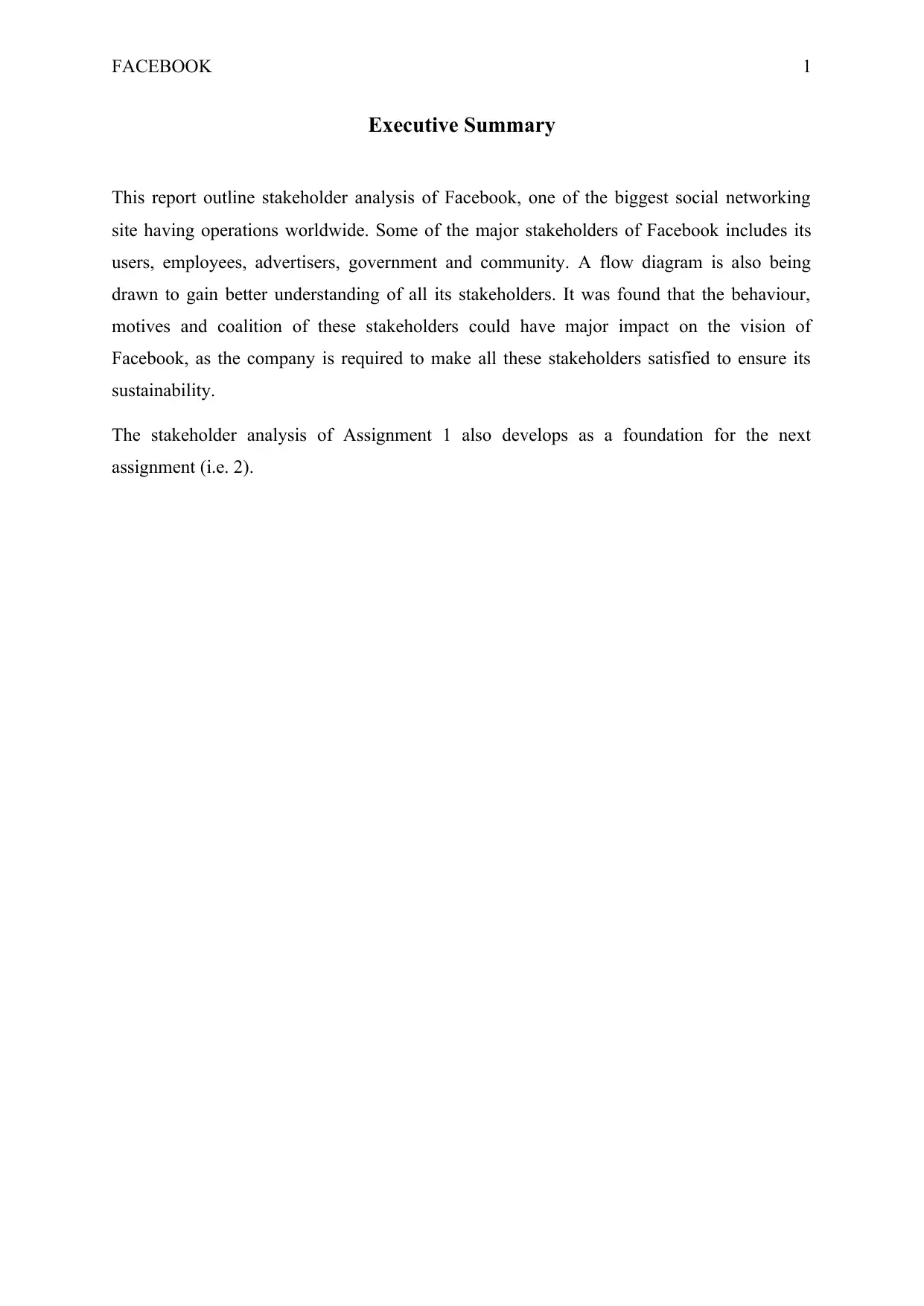
FACEBOOK 1
Executive Summary
This report outline stakeholder analysis of Facebook, one of the biggest social networking
site having operations worldwide. Some of the major stakeholders of Facebook includes its
users, employees, advertisers, government and community. A flow diagram is also being
drawn to gain better understanding of all its stakeholders. It was found that the behaviour,
motives and coalition of these stakeholders could have major impact on the vision of
Facebook, as the company is required to make all these stakeholders satisfied to ensure its
sustainability.
The stakeholder analysis of Assignment 1 also develops as a foundation for the next
assignment (i.e. 2).
Executive Summary
This report outline stakeholder analysis of Facebook, one of the biggest social networking
site having operations worldwide. Some of the major stakeholders of Facebook includes its
users, employees, advertisers, government and community. A flow diagram is also being
drawn to gain better understanding of all its stakeholders. It was found that the behaviour,
motives and coalition of these stakeholders could have major impact on the vision of
Facebook, as the company is required to make all these stakeholders satisfied to ensure its
sustainability.
The stakeholder analysis of Assignment 1 also develops as a foundation for the next
assignment (i.e. 2).
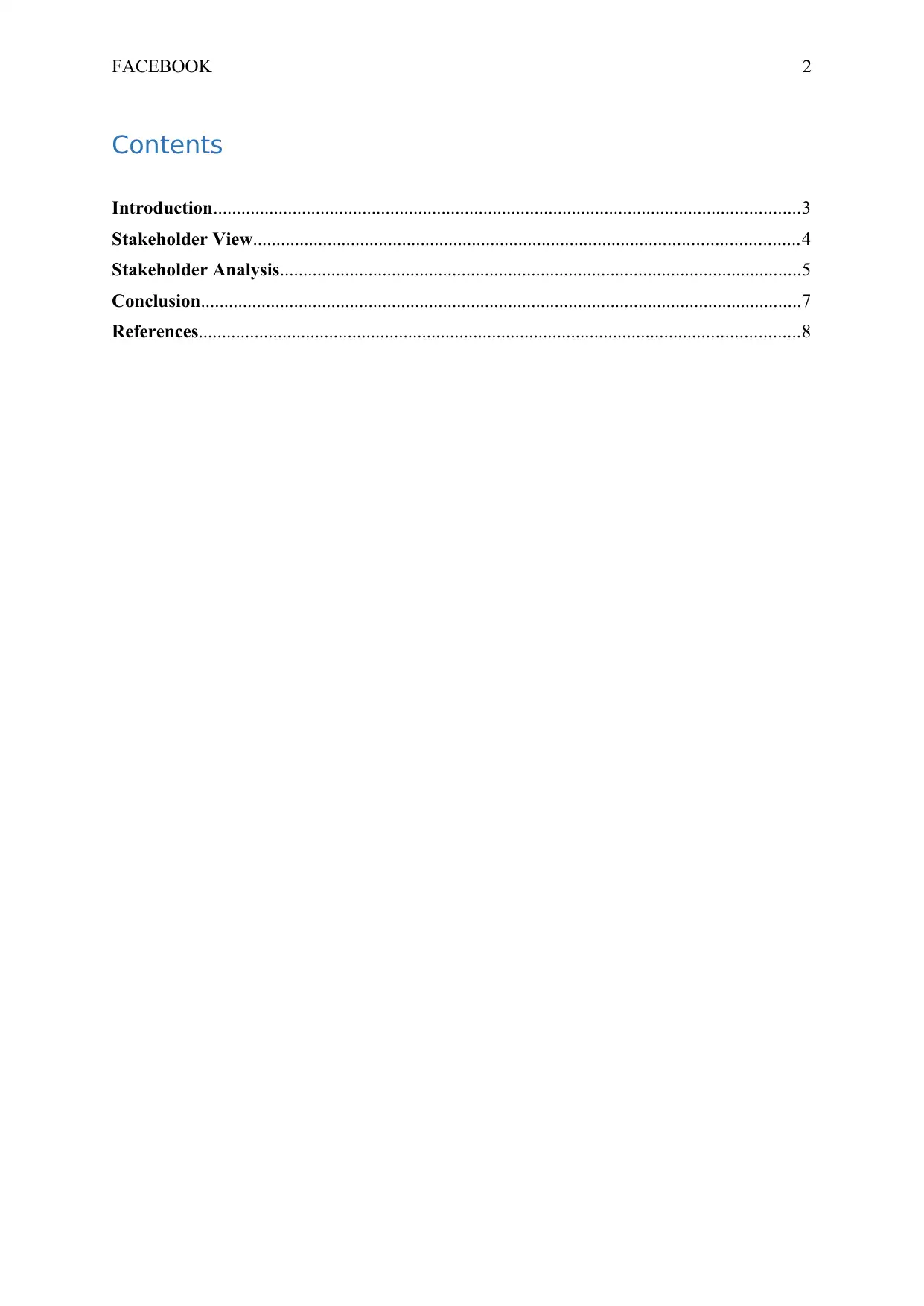
FACEBOOK 2
Contents
Introduction..............................................................................................................................3
Stakeholder View.....................................................................................................................4
Stakeholder Analysis................................................................................................................5
Conclusion.................................................................................................................................7
References.................................................................................................................................8
Contents
Introduction..............................................................................................................................3
Stakeholder View.....................................................................................................................4
Stakeholder Analysis................................................................................................................5
Conclusion.................................................................................................................................7
References.................................................................................................................................8
⊘ This is a preview!⊘
Do you want full access?
Subscribe today to unlock all pages.

Trusted by 1+ million students worldwide
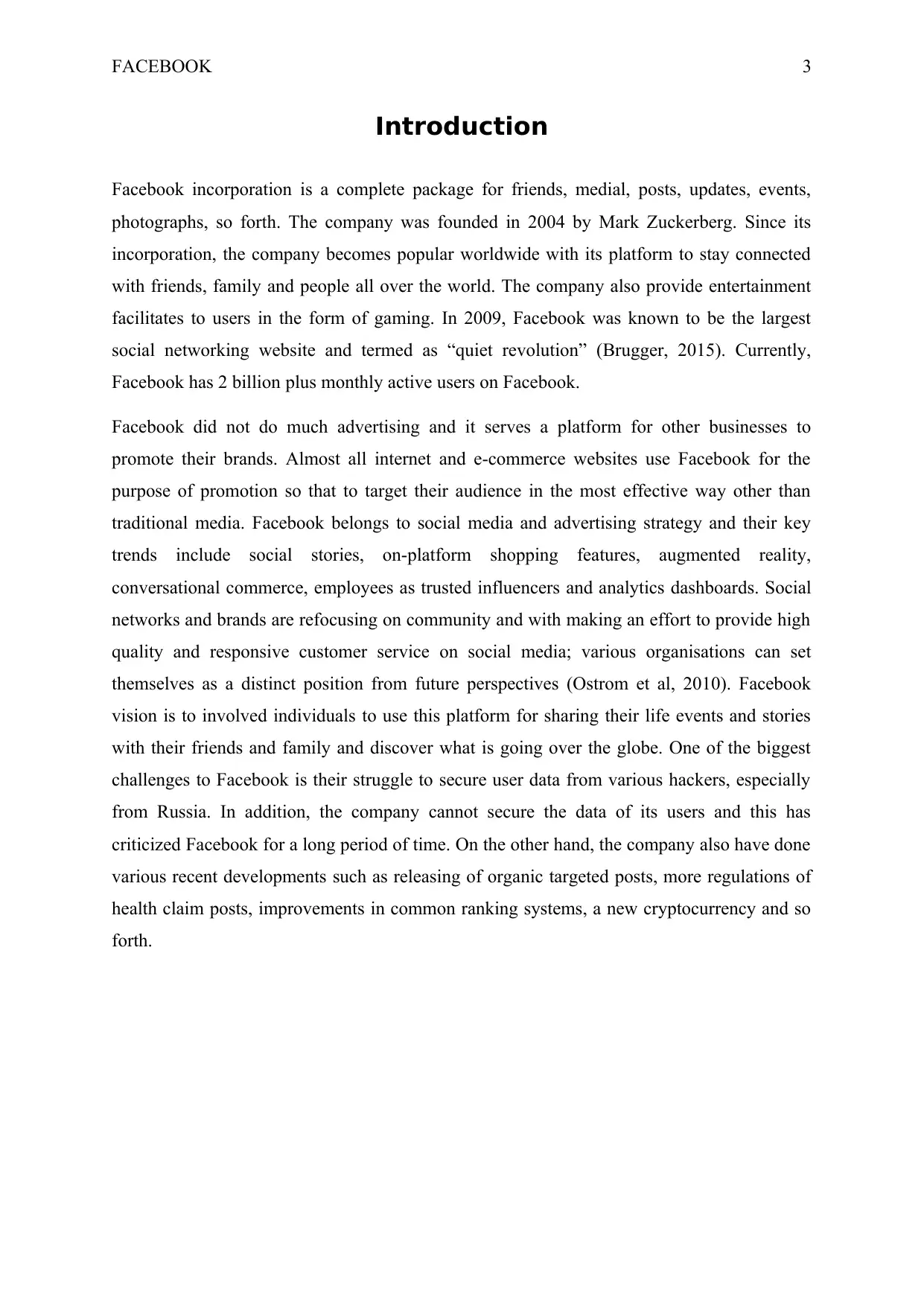
FACEBOOK 3
Introduction
Facebook incorporation is a complete package for friends, medial, posts, updates, events,
photographs, so forth. The company was founded in 2004 by Mark Zuckerberg. Since its
incorporation, the company becomes popular worldwide with its platform to stay connected
with friends, family and people all over the world. The company also provide entertainment
facilitates to users in the form of gaming. In 2009, Facebook was known to be the largest
social networking website and termed as “quiet revolution” (Brugger, 2015). Currently,
Facebook has 2 billion plus monthly active users on Facebook.
Facebook did not do much advertising and it serves a platform for other businesses to
promote their brands. Almost all internet and e-commerce websites use Facebook for the
purpose of promotion so that to target their audience in the most effective way other than
traditional media. Facebook belongs to social media and advertising strategy and their key
trends include social stories, on-platform shopping features, augmented reality,
conversational commerce, employees as trusted influencers and analytics dashboards. Social
networks and brands are refocusing on community and with making an effort to provide high
quality and responsive customer service on social media; various organisations can set
themselves as a distinct position from future perspectives (Ostrom et al, 2010). Facebook
vision is to involved individuals to use this platform for sharing their life events and stories
with their friends and family and discover what is going over the globe. One of the biggest
challenges to Facebook is their struggle to secure user data from various hackers, especially
from Russia. In addition, the company cannot secure the data of its users and this has
criticized Facebook for a long period of time. On the other hand, the company also have done
various recent developments such as releasing of organic targeted posts, more regulations of
health claim posts, improvements in common ranking systems, a new cryptocurrency and so
forth.
Introduction
Facebook incorporation is a complete package for friends, medial, posts, updates, events,
photographs, so forth. The company was founded in 2004 by Mark Zuckerberg. Since its
incorporation, the company becomes popular worldwide with its platform to stay connected
with friends, family and people all over the world. The company also provide entertainment
facilitates to users in the form of gaming. In 2009, Facebook was known to be the largest
social networking website and termed as “quiet revolution” (Brugger, 2015). Currently,
Facebook has 2 billion plus monthly active users on Facebook.
Facebook did not do much advertising and it serves a platform for other businesses to
promote their brands. Almost all internet and e-commerce websites use Facebook for the
purpose of promotion so that to target their audience in the most effective way other than
traditional media. Facebook belongs to social media and advertising strategy and their key
trends include social stories, on-platform shopping features, augmented reality,
conversational commerce, employees as trusted influencers and analytics dashboards. Social
networks and brands are refocusing on community and with making an effort to provide high
quality and responsive customer service on social media; various organisations can set
themselves as a distinct position from future perspectives (Ostrom et al, 2010). Facebook
vision is to involved individuals to use this platform for sharing their life events and stories
with their friends and family and discover what is going over the globe. One of the biggest
challenges to Facebook is their struggle to secure user data from various hackers, especially
from Russia. In addition, the company cannot secure the data of its users and this has
criticized Facebook for a long period of time. On the other hand, the company also have done
various recent developments such as releasing of organic targeted posts, more regulations of
health claim posts, improvements in common ranking systems, a new cryptocurrency and so
forth.
Paraphrase This Document
Need a fresh take? Get an instant paraphrase of this document with our AI Paraphraser
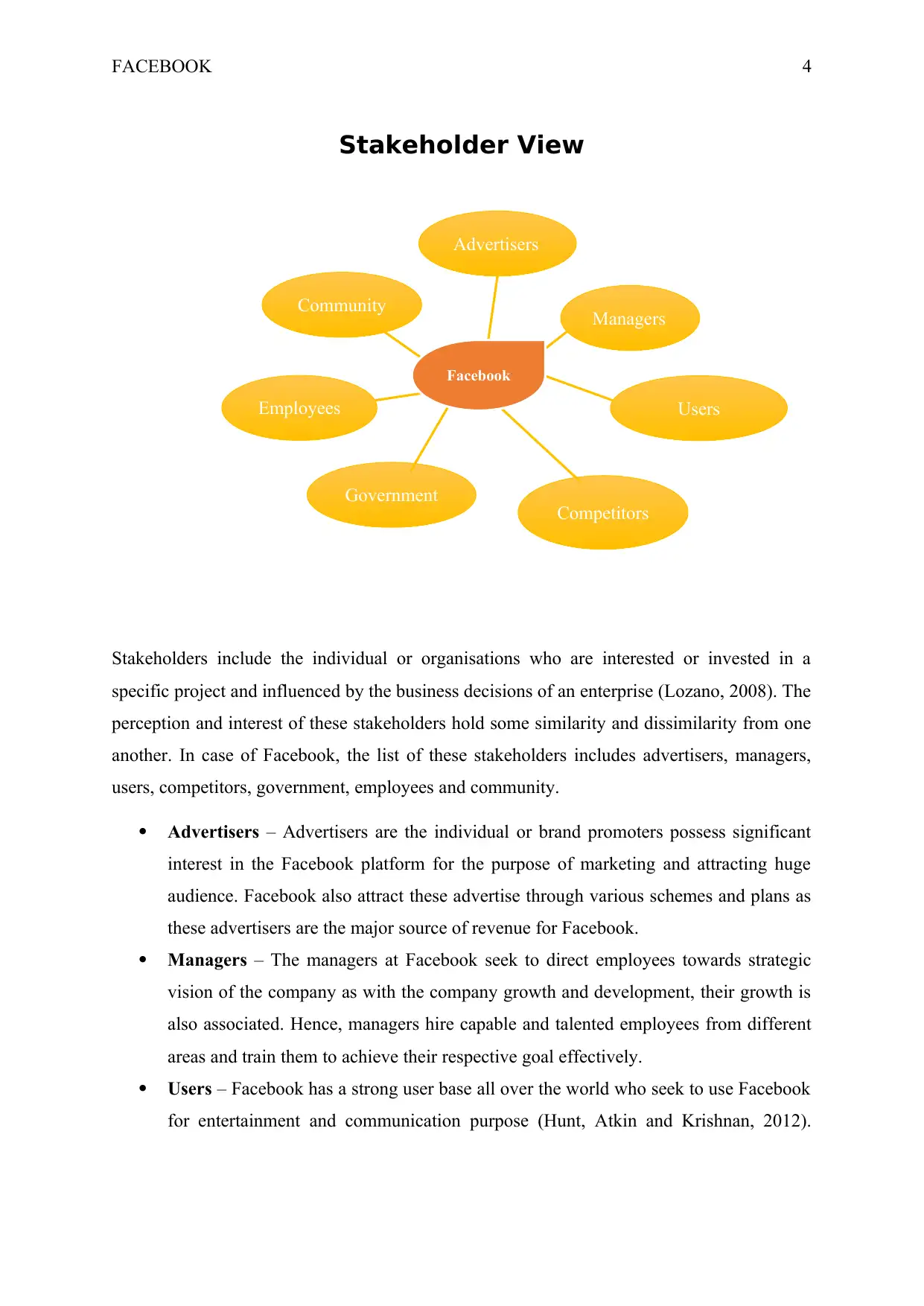
FACEBOOK 4
Stakeholder View
Stakeholders include the individual or organisations who are interested or invested in a
specific project and influenced by the business decisions of an enterprise (Lozano, 2008). The
perception and interest of these stakeholders hold some similarity and dissimilarity from one
another. In case of Facebook, the list of these stakeholders includes advertisers, managers,
users, competitors, government, employees and community.
Advertisers – Advertisers are the individual or brand promoters possess significant
interest in the Facebook platform for the purpose of marketing and attracting huge
audience. Facebook also attract these advertise through various schemes and plans as
these advertisers are the major source of revenue for Facebook.
Managers – The managers at Facebook seek to direct employees towards strategic
vision of the company as with the company growth and development, their growth is
also associated. Hence, managers hire capable and talented employees from different
areas and train them to achieve their respective goal effectively.
Users – Facebook has a strong user base all over the world who seek to use Facebook
for entertainment and communication purpose (Hunt, Atkin and Krishnan, 2012).
Community
UsersEmployees
Government Competitors
Managers
Advertisers
Facebook
Stakeholder View
Stakeholders include the individual or organisations who are interested or invested in a
specific project and influenced by the business decisions of an enterprise (Lozano, 2008). The
perception and interest of these stakeholders hold some similarity and dissimilarity from one
another. In case of Facebook, the list of these stakeholders includes advertisers, managers,
users, competitors, government, employees and community.
Advertisers – Advertisers are the individual or brand promoters possess significant
interest in the Facebook platform for the purpose of marketing and attracting huge
audience. Facebook also attract these advertise through various schemes and plans as
these advertisers are the major source of revenue for Facebook.
Managers – The managers at Facebook seek to direct employees towards strategic
vision of the company as with the company growth and development, their growth is
also associated. Hence, managers hire capable and talented employees from different
areas and train them to achieve their respective goal effectively.
Users – Facebook has a strong user base all over the world who seek to use Facebook
for entertainment and communication purpose (Hunt, Atkin and Krishnan, 2012).
Community
UsersEmployees
Government Competitors
Managers
Advertisers
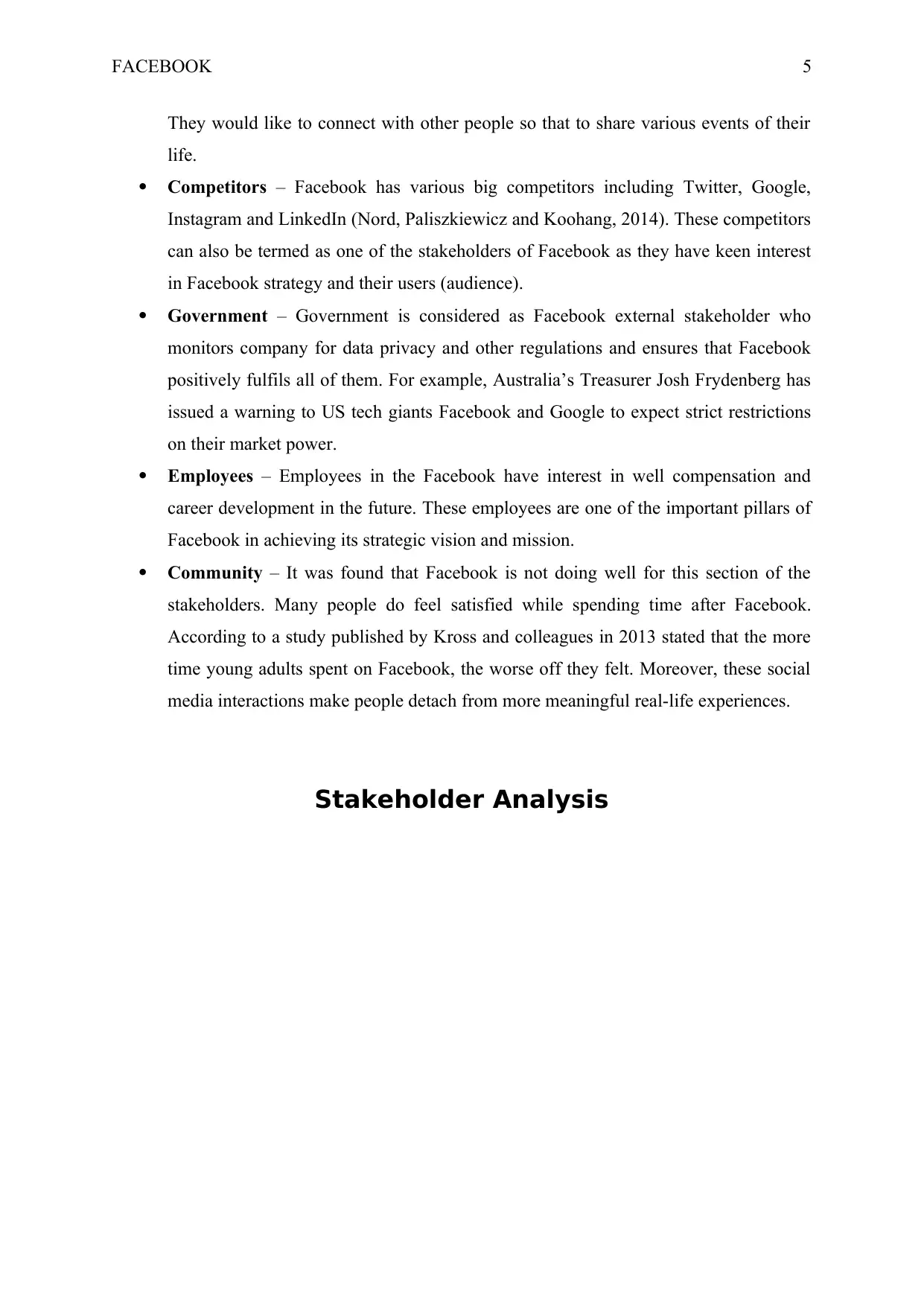
FACEBOOK 5
They would like to connect with other people so that to share various events of their
life.
Competitors – Facebook has various big competitors including Twitter, Google,
Instagram and LinkedIn (Nord, Paliszkiewicz and Koohang, 2014). These competitors
can also be termed as one of the stakeholders of Facebook as they have keen interest
in Facebook strategy and their users (audience).
Government – Government is considered as Facebook external stakeholder who
monitors company for data privacy and other regulations and ensures that Facebook
positively fulfils all of them. For example, Australia’s Treasurer Josh Frydenberg has
issued a warning to US tech giants Facebook and Google to expect strict restrictions
on their market power.
Employees – Employees in the Facebook have interest in well compensation and
career development in the future. These employees are one of the important pillars of
Facebook in achieving its strategic vision and mission.
Community – It was found that Facebook is not doing well for this section of the
stakeholders. Many people do feel satisfied while spending time after Facebook.
According to a study published by Kross and colleagues in 2013 stated that the more
time young adults spent on Facebook, the worse off they felt. Moreover, these social
media interactions make people detach from more meaningful real-life experiences.
Stakeholder Analysis
They would like to connect with other people so that to share various events of their
life.
Competitors – Facebook has various big competitors including Twitter, Google,
Instagram and LinkedIn (Nord, Paliszkiewicz and Koohang, 2014). These competitors
can also be termed as one of the stakeholders of Facebook as they have keen interest
in Facebook strategy and their users (audience).
Government – Government is considered as Facebook external stakeholder who
monitors company for data privacy and other regulations and ensures that Facebook
positively fulfils all of them. For example, Australia’s Treasurer Josh Frydenberg has
issued a warning to US tech giants Facebook and Google to expect strict restrictions
on their market power.
Employees – Employees in the Facebook have interest in well compensation and
career development in the future. These employees are one of the important pillars of
Facebook in achieving its strategic vision and mission.
Community – It was found that Facebook is not doing well for this section of the
stakeholders. Many people do feel satisfied while spending time after Facebook.
According to a study published by Kross and colleagues in 2013 stated that the more
time young adults spent on Facebook, the worse off they felt. Moreover, these social
media interactions make people detach from more meaningful real-life experiences.
Stakeholder Analysis
⊘ This is a preview!⊘
Do you want full access?
Subscribe today to unlock all pages.

Trusted by 1+ million students worldwide
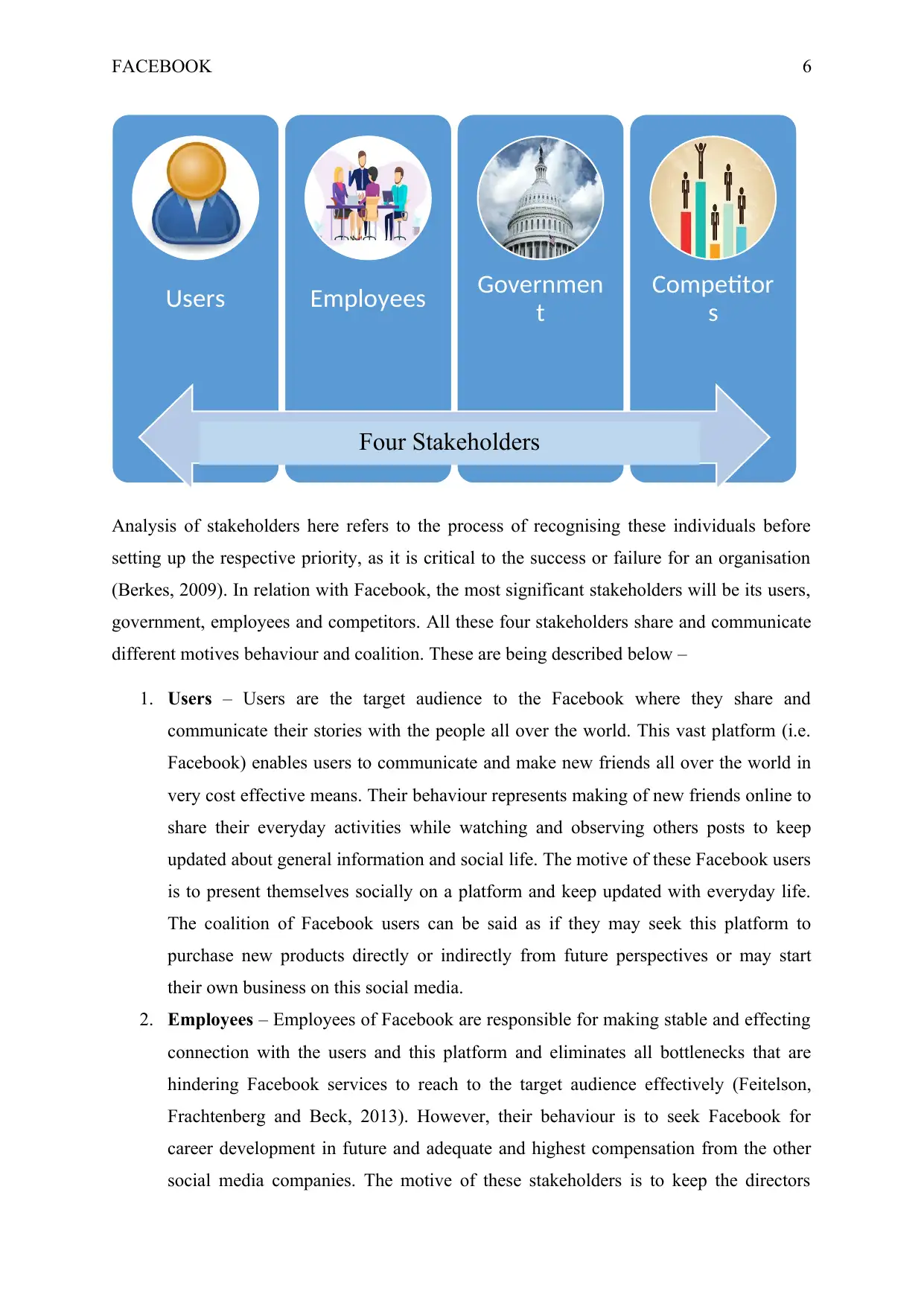
FACEBOOK 6
Analysis of stakeholders here refers to the process of recognising these individuals before
setting up the respective priority, as it is critical to the success or failure for an organisation
(Berkes, 2009). In relation with Facebook, the most significant stakeholders will be its users,
government, employees and competitors. All these four stakeholders share and communicate
different motives behaviour and coalition. These are being described below –
1. Users – Users are the target audience to the Facebook where they share and
communicate their stories with the people all over the world. This vast platform (i.e.
Facebook) enables users to communicate and make new friends all over the world in
very cost effective means. Their behaviour represents making of new friends online to
share their everyday activities while watching and observing others posts to keep
updated about general information and social life. The motive of these Facebook users
is to present themselves socially on a platform and keep updated with everyday life.
The coalition of Facebook users can be said as if they may seek this platform to
purchase new products directly or indirectly from future perspectives or may start
their own business on this social media.
2. Employees – Employees of Facebook are responsible for making stable and effecting
connection with the users and this platform and eliminates all bottlenecks that are
hindering Facebook services to reach to the target audience effectively (Feitelson,
Frachtenberg and Beck, 2013). However, their behaviour is to seek Facebook for
career development in future and adequate and highest compensation from the other
social media companies. The motive of these stakeholders is to keep the directors
Users Employees Governmen
t
Competitor
s
Four Stakeholders
Analysis of stakeholders here refers to the process of recognising these individuals before
setting up the respective priority, as it is critical to the success or failure for an organisation
(Berkes, 2009). In relation with Facebook, the most significant stakeholders will be its users,
government, employees and competitors. All these four stakeholders share and communicate
different motives behaviour and coalition. These are being described below –
1. Users – Users are the target audience to the Facebook where they share and
communicate their stories with the people all over the world. This vast platform (i.e.
Facebook) enables users to communicate and make new friends all over the world in
very cost effective means. Their behaviour represents making of new friends online to
share their everyday activities while watching and observing others posts to keep
updated about general information and social life. The motive of these Facebook users
is to present themselves socially on a platform and keep updated with everyday life.
The coalition of Facebook users can be said as if they may seek this platform to
purchase new products directly or indirectly from future perspectives or may start
their own business on this social media.
2. Employees – Employees of Facebook are responsible for making stable and effecting
connection with the users and this platform and eliminates all bottlenecks that are
hindering Facebook services to reach to the target audience effectively (Feitelson,
Frachtenberg and Beck, 2013). However, their behaviour is to seek Facebook for
career development in future and adequate and highest compensation from the other
social media companies. The motive of these stakeholders is to keep the directors
Users Employees Governmen
t
Competitor
s
Four Stakeholders
Paraphrase This Document
Need a fresh take? Get an instant paraphrase of this document with our AI Paraphraser
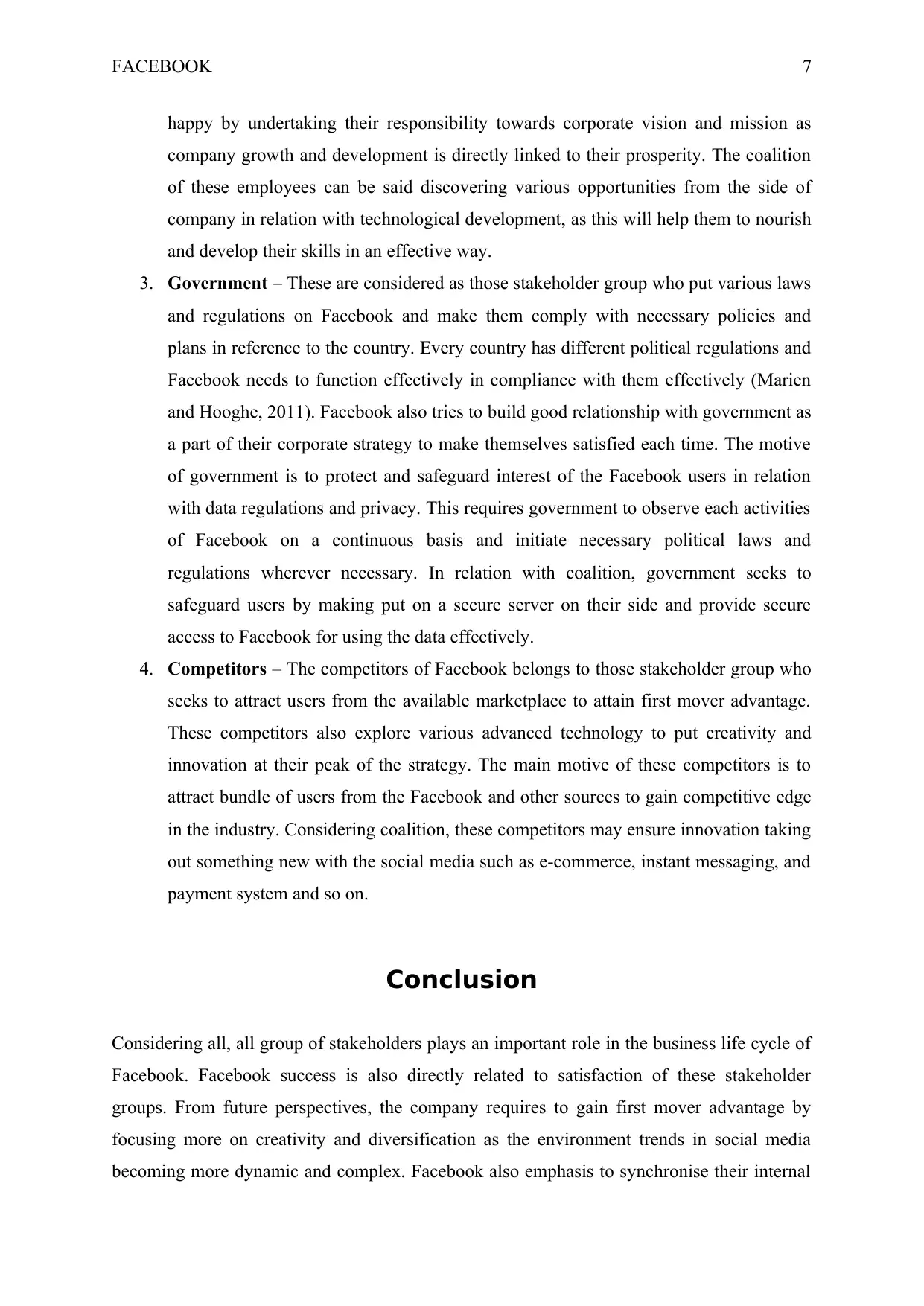
FACEBOOK 7
happy by undertaking their responsibility towards corporate vision and mission as
company growth and development is directly linked to their prosperity. The coalition
of these employees can be said discovering various opportunities from the side of
company in relation with technological development, as this will help them to nourish
and develop their skills in an effective way.
3. Government – These are considered as those stakeholder group who put various laws
and regulations on Facebook and make them comply with necessary policies and
plans in reference to the country. Every country has different political regulations and
Facebook needs to function effectively in compliance with them effectively (Marien
and Hooghe, 2011). Facebook also tries to build good relationship with government as
a part of their corporate strategy to make themselves satisfied each time. The motive
of government is to protect and safeguard interest of the Facebook users in relation
with data regulations and privacy. This requires government to observe each activities
of Facebook on a continuous basis and initiate necessary political laws and
regulations wherever necessary. In relation with coalition, government seeks to
safeguard users by making put on a secure server on their side and provide secure
access to Facebook for using the data effectively.
4. Competitors – The competitors of Facebook belongs to those stakeholder group who
seeks to attract users from the available marketplace to attain first mover advantage.
These competitors also explore various advanced technology to put creativity and
innovation at their peak of the strategy. The main motive of these competitors is to
attract bundle of users from the Facebook and other sources to gain competitive edge
in the industry. Considering coalition, these competitors may ensure innovation taking
out something new with the social media such as e-commerce, instant messaging, and
payment system and so on.
Conclusion
Considering all, all group of stakeholders plays an important role in the business life cycle of
Facebook. Facebook success is also directly related to satisfaction of these stakeholder
groups. From future perspectives, the company requires to gain first mover advantage by
focusing more on creativity and diversification as the environment trends in social media
becoming more dynamic and complex. Facebook also emphasis to synchronise their internal
happy by undertaking their responsibility towards corporate vision and mission as
company growth and development is directly linked to their prosperity. The coalition
of these employees can be said discovering various opportunities from the side of
company in relation with technological development, as this will help them to nourish
and develop their skills in an effective way.
3. Government – These are considered as those stakeholder group who put various laws
and regulations on Facebook and make them comply with necessary policies and
plans in reference to the country. Every country has different political regulations and
Facebook needs to function effectively in compliance with them effectively (Marien
and Hooghe, 2011). Facebook also tries to build good relationship with government as
a part of their corporate strategy to make themselves satisfied each time. The motive
of government is to protect and safeguard interest of the Facebook users in relation
with data regulations and privacy. This requires government to observe each activities
of Facebook on a continuous basis and initiate necessary political laws and
regulations wherever necessary. In relation with coalition, government seeks to
safeguard users by making put on a secure server on their side and provide secure
access to Facebook for using the data effectively.
4. Competitors – The competitors of Facebook belongs to those stakeholder group who
seeks to attract users from the available marketplace to attain first mover advantage.
These competitors also explore various advanced technology to put creativity and
innovation at their peak of the strategy. The main motive of these competitors is to
attract bundle of users from the Facebook and other sources to gain competitive edge
in the industry. Considering coalition, these competitors may ensure innovation taking
out something new with the social media such as e-commerce, instant messaging, and
payment system and so on.
Conclusion
Considering all, all group of stakeholders plays an important role in the business life cycle of
Facebook. Facebook success is also directly related to satisfaction of these stakeholder
groups. From future perspectives, the company requires to gain first mover advantage by
focusing more on creativity and diversification as the environment trends in social media
becoming more dynamic and complex. Facebook also emphasis to synchronise their internal
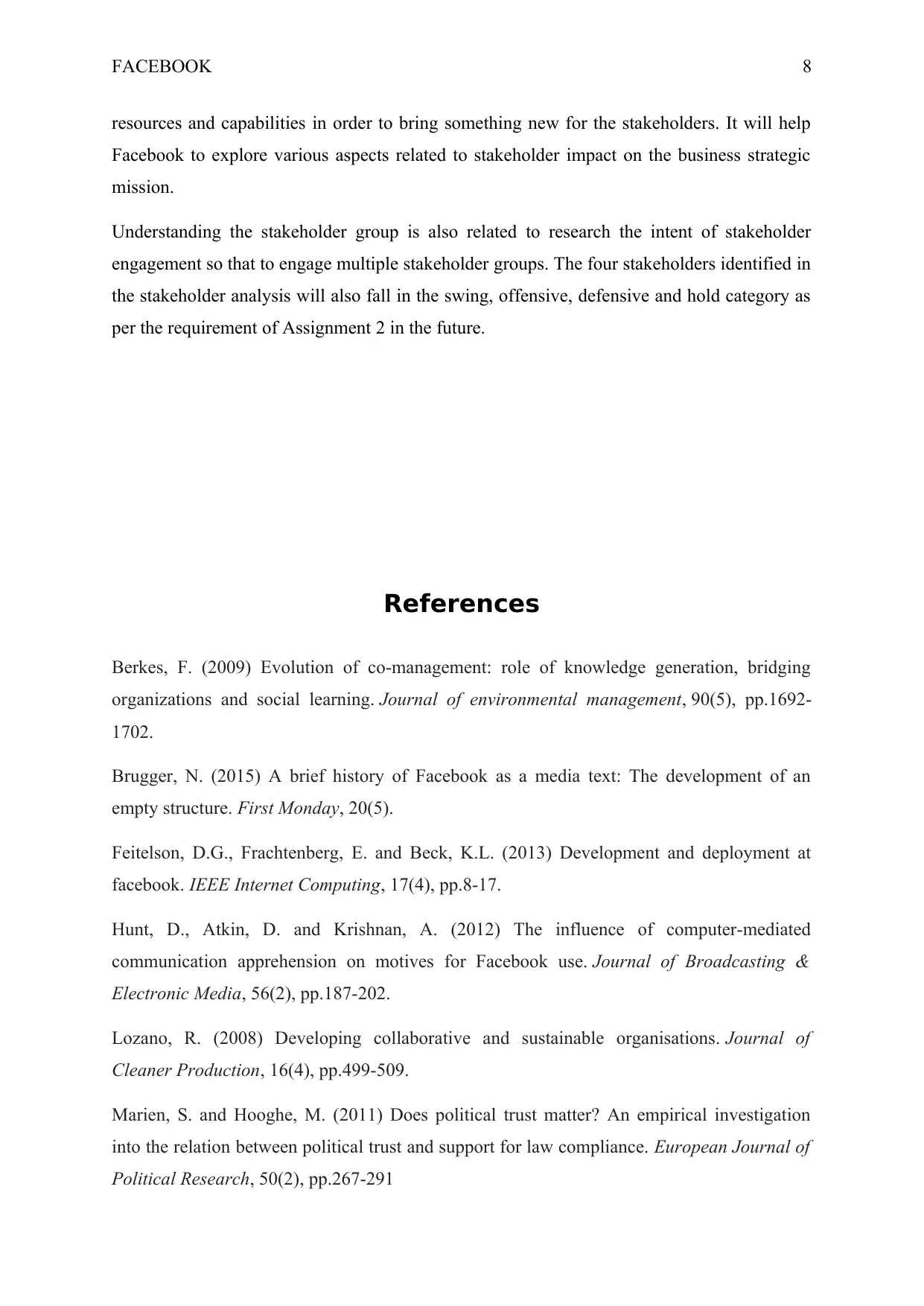
FACEBOOK 8
resources and capabilities in order to bring something new for the stakeholders. It will help
Facebook to explore various aspects related to stakeholder impact on the business strategic
mission.
Understanding the stakeholder group is also related to research the intent of stakeholder
engagement so that to engage multiple stakeholder groups. The four stakeholders identified in
the stakeholder analysis will also fall in the swing, offensive, defensive and hold category as
per the requirement of Assignment 2 in the future.
References
Berkes, F. (2009) Evolution of co-management: role of knowledge generation, bridging
organizations and social learning. Journal of environmental management, 90(5), pp.1692-
1702.
Brugger, N. (2015) A brief history of Facebook as a media text: The development of an
empty structure. First Monday, 20(5).
Feitelson, D.G., Frachtenberg, E. and Beck, K.L. (2013) Development and deployment at
facebook. IEEE Internet Computing, 17(4), pp.8-17.
Hunt, D., Atkin, D. and Krishnan, A. (2012) The influence of computer-mediated
communication apprehension on motives for Facebook use. Journal of Broadcasting &
Electronic Media, 56(2), pp.187-202.
Lozano, R. (2008) Developing collaborative and sustainable organisations. Journal of
Cleaner Production, 16(4), pp.499-509.
Marien, S. and Hooghe, M. (2011) Does political trust matter? An empirical investigation
into the relation between political trust and support for law compliance. European Journal of
Political Research, 50(2), pp.267-291
resources and capabilities in order to bring something new for the stakeholders. It will help
Facebook to explore various aspects related to stakeholder impact on the business strategic
mission.
Understanding the stakeholder group is also related to research the intent of stakeholder
engagement so that to engage multiple stakeholder groups. The four stakeholders identified in
the stakeholder analysis will also fall in the swing, offensive, defensive and hold category as
per the requirement of Assignment 2 in the future.
References
Berkes, F. (2009) Evolution of co-management: role of knowledge generation, bridging
organizations and social learning. Journal of environmental management, 90(5), pp.1692-
1702.
Brugger, N. (2015) A brief history of Facebook as a media text: The development of an
empty structure. First Monday, 20(5).
Feitelson, D.G., Frachtenberg, E. and Beck, K.L. (2013) Development and deployment at
facebook. IEEE Internet Computing, 17(4), pp.8-17.
Hunt, D., Atkin, D. and Krishnan, A. (2012) The influence of computer-mediated
communication apprehension on motives for Facebook use. Journal of Broadcasting &
Electronic Media, 56(2), pp.187-202.
Lozano, R. (2008) Developing collaborative and sustainable organisations. Journal of
Cleaner Production, 16(4), pp.499-509.
Marien, S. and Hooghe, M. (2011) Does political trust matter? An empirical investigation
into the relation between political trust and support for law compliance. European Journal of
Political Research, 50(2), pp.267-291
⊘ This is a preview!⊘
Do you want full access?
Subscribe today to unlock all pages.

Trusted by 1+ million students worldwide
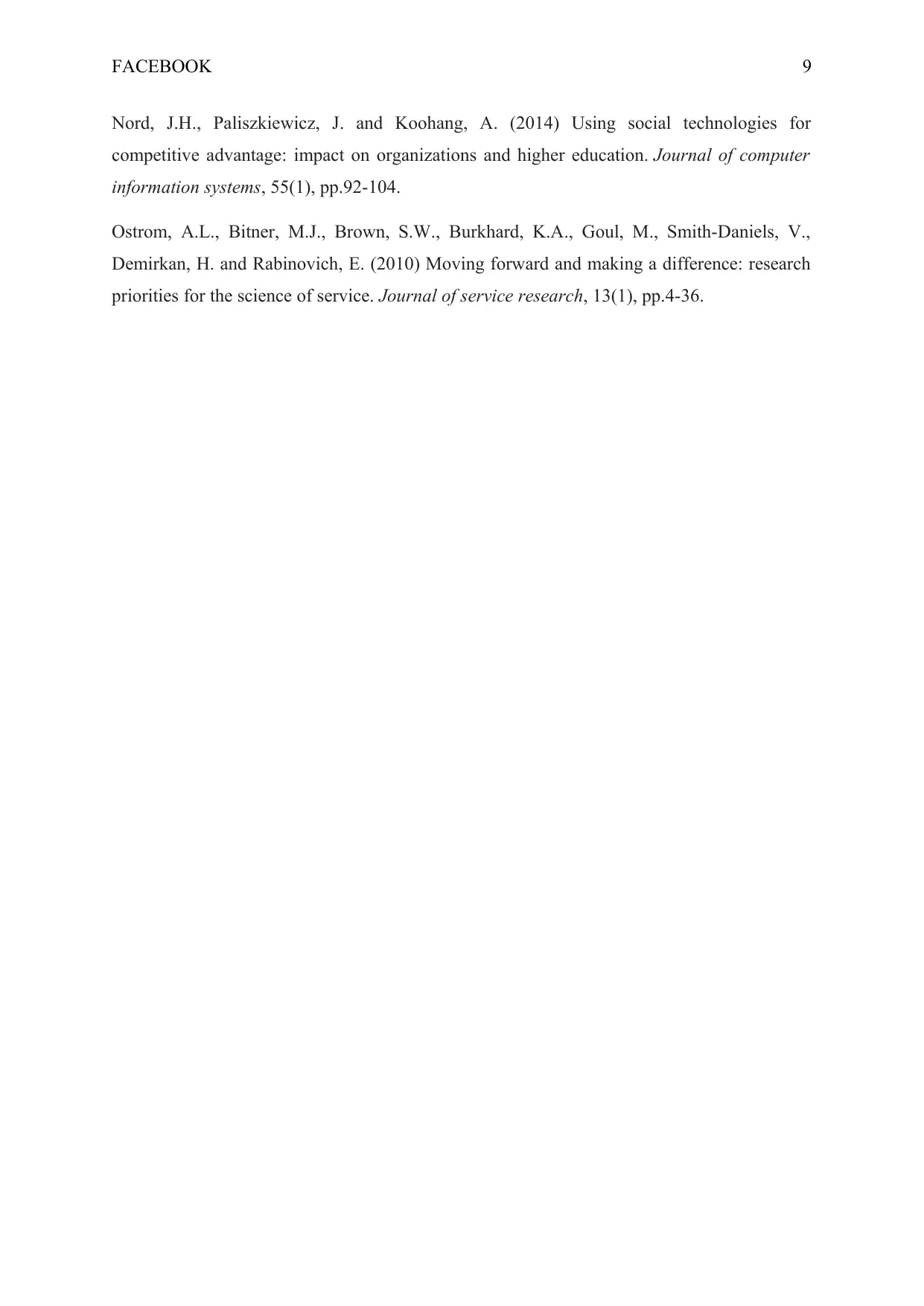
FACEBOOK 9
Nord, J.H., Paliszkiewicz, J. and Koohang, A. (2014) Using social technologies for
competitive advantage: impact on organizations and higher education. Journal of computer
information systems, 55(1), pp.92-104.
Ostrom, A.L., Bitner, M.J., Brown, S.W., Burkhard, K.A., Goul, M., Smith-Daniels, V.,
Demirkan, H. and Rabinovich, E. (2010) Moving forward and making a difference: research
priorities for the science of service. Journal of service research, 13(1), pp.4-36.
Nord, J.H., Paliszkiewicz, J. and Koohang, A. (2014) Using social technologies for
competitive advantage: impact on organizations and higher education. Journal of computer
information systems, 55(1), pp.92-104.
Ostrom, A.L., Bitner, M.J., Brown, S.W., Burkhard, K.A., Goul, M., Smith-Daniels, V.,
Demirkan, H. and Rabinovich, E. (2010) Moving forward and making a difference: research
priorities for the science of service. Journal of service research, 13(1), pp.4-36.
1 out of 10
Related Documents
Your All-in-One AI-Powered Toolkit for Academic Success.
+13062052269
info@desklib.com
Available 24*7 on WhatsApp / Email
![[object Object]](/_next/static/media/star-bottom.7253800d.svg)
Unlock your academic potential
Copyright © 2020–2025 A2Z Services. All Rights Reserved. Developed and managed by ZUCOL.





